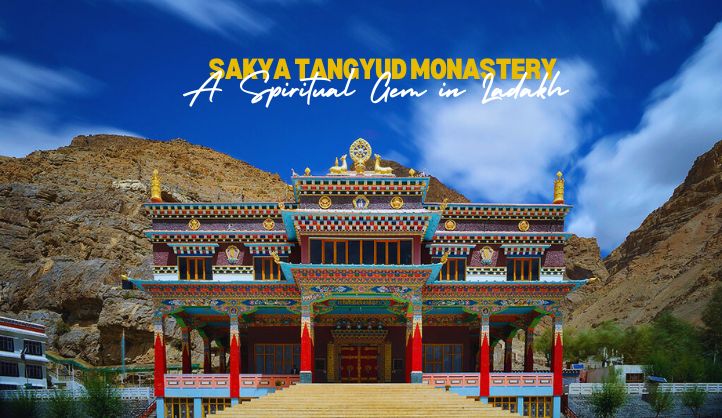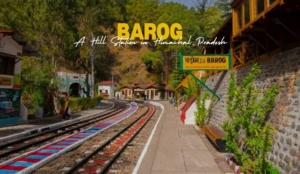The Sakya Tangyud Monastery, nestled in the tranquil region of Ladakh, is a serene and culturally rich Tibetan Buddhist monastery that stands as a significant spiritual site in the region. Located about 12 kilometers from the town of Leh, the monastery offers a peaceful retreat with its breathtaking views of the Himalayan mountains and the stark beauty of the Ladakhi landscape.
Historical Significance
Sakya Tangyud Monastery was founded in the 15th century by the Lama Shesrab Zangpo, a revered Tibetan Buddhist monk. It is part of the Sakya tradition of Tibetan Buddhism, one of the four major schools of Tibetan Buddhism, known for its emphasis on the teachings of the Buddha and the preservation of Tibetan culture. The monastery’s name, “Sakya Tangyud,” roughly translates to “The Monastery of the Sakyapa Tradition.”
Historically, Sakya Tangyud was an important center for Buddhist learning and spiritual practice. Over the centuries, it has attracted numerous pilgrims and devotees, owing to its rich spiritual heritage and its role in preserving Tibetan Buddhism in Ladakh. The monastery is also known for being one of the highest monasteries in the region, perched on a hill that offers spectacular panoramic views.
Architectural Features
The architecture of Sakya Tangyud Monastery is a stunning reflection of the Tibetan Buddhist style, blending traditional design with the natural surroundings. The monastery is adorned with vibrant frescoes, intricate murals, and spiritual symbols that depict Buddhist teachings, legends, and deities. The monastery’s prayer hall is the main focal point, housing numerous statues of Buddhist deities, including those of Buddha Shakyamuni and various Bodhisattvas.
One of the key highlights of the monastery is its towering central stupa, which serves as a point of meditation and prayer for visitors. The monastery’s courtyard and surrounding areas are dotted with prayer wheels and prayer flags, adding to the spiritual ambiance.
Cultural Importance
Beyond its religious significance, the Sakya Tangyud Monastery is an important cultural landmark for the people of Ladakh. It serves as a hub for the local Buddhist community, hosting regular prayer ceremonies, festivals, and religious events. The monks of the monastery continue to maintain ancient traditions of Tibetan Buddhism, including meditation, rituals, and the study of sacred texts.
The monastery also plays a vital role in preserving Ladakhi culture, particularly through its efforts to educate younger generations about Buddhist philosophy and Tibetan art forms. It acts as a bridge between the ancient traditions of Tibet and the modern world, ensuring that the region’s spiritual heritage remains intact.
Visiting Sakya Tangyud Monastery
Visitors to Sakya Tangyud Monastery can expect a tranquil experience, surrounded by the beauty of Ladakh’s barren yet majestic landscape. The journey to the monastery itself is a spiritual experience, as it involves a scenic drive through the winding roads of Leh, with the towering mountains as a backdrop. Upon reaching the monastery, visitors can take part in meditation sessions or simply soak in the serene atmosphere.
The best time to visit Sakya Tangyud is during the summer months when the weather is pleasant, and the monastery is open to pilgrims and tourists alike. Visitors are also encouraged to engage with the monks and learn about their way of life, including their meditation practices, daily routines, and religious ceremonies.
Nearby Places to Explore Around Sakya Tangyud Monastery
The Sakya Tangyud Monastery, located in the stunning region of Ladakh, is surrounded by several other fascinating places that capture the essence of Ladakh’s rich cultural, historical, and natural beauty. Here are some of the notable nearby attractions to visit when you’re in the area:
1. Leh Palace
Located about 12 kilometers from Sakya Tangyud Monastery, Leh Palace is one of the most prominent historical landmarks in Ladakh. Built in the 17th century by King Sengge Namgyal, this palace is a spectacular example of Tibetan architecture. Visitors can explore the ruined structure and enjoy panoramic views of Leh town, the Indus River, and the surrounding mountains. It’s an excellent spot for photography and a dive into Ladakh’s royal history.
2. Thiksey Monastery
Sakya Tangyud, Thiksey Monastery is one of the largest and most famous monasteries in Ladakh. Known for its impressive architecture, Thiksey is often compared to the Potala Palace in Tibet. The monastery houses numerous statues, stupas, and murals, and its prayer hall is particularly famous for a large statue of Maitreya Buddha. The monastery offers beautiful views of the surrounding valley and is a peaceful place for reflection.
3. Hemis Monastery
Hemis Monastery is one of the largest and wealthiest monasteries in Ladakh. Founded in the 17th century, this Buddhist monastery is famous for its annual Hemis festival, which attracts pilgrims and tourists from around the world. The monastery houses a rich collection of artifacts, murals, and a vast library of ancient texts. It is located in a beautiful valley and offers stunning views of the surrounding mountains.
4. Nubra Valley
Nubra Valley is a captivating destination known for its unique landscape, dunes, and monasteries. The valley is home to the famous Diskit Monastery, which overlooks the Nubra River. The region offers opportunities for adventure activities like camel rides, trekking, and exploring the picturesque villages of the valley. The high-altitude desert landscape with its dramatic mountains makes Nubra Valley a must-visit destination in Ladakh.
5. Pangong Lake
Pangong Lake is one of the most iconic natural attractions in Ladakh. The lake is known for its striking turquoise waters and the dramatic mountain backdrop that changes color throughout the day. Visitors can enjoy boating or simply soak in the breathtaking scenery. Pangong Lake gained international fame after being featured in the Bollywood movie 3 Idiots.
6. Magnetic Hill
Magnetic Hill is a mysterious place that attracts visitors due to its optical illusion. Vehicles parked in neutral gear appear to roll uphill against the force of gravity, creating an inexplicable phenomenon that has puzzled many. The site is an interesting stop for those looking to experience something unusual in Ladakh.
7. Shanti Stupa
Shanti Stupa is a beautiful Buddhist monument dedicated to world peace. The stupa was built by the Japanese Buddhists in collaboration with the Ladakhi people. It offers breathtaking views of the Leh Valley and the surrounding mountains, making it a peaceful place for meditation and contemplation. The stupa is especially beautiful during sunrise and sunset.
8. Khardung La Pass
Khardung La is one of the highest motorable passes in the world, standing at an altitude of 5,359 meters (17,582 feet) above sea level. It offers spectacular views of the surrounding mountains and the Nubra Valley. It’s a popular destination for adventurous travelers, especially for those seeking an off-road experience and a chance to witness the rugged terrain of Ladakh.
9. Stok Palace and Museum
Stok Palace was the residence of the royal family of Ladakh. Today, it is open to visitors, offering a glimpse into the traditional life of Ladakhi royalty. The palace is known for its beautiful architecture, traditional Ladakhi decor, and the Stok Museum, which houses a collection of royal artifacts, costumes, and weapons.
10. Zanskar Valley
Zanskar Valley is a remote and rugged region of Ladakh that offers a true escape into nature. Known for its dramatic landscapes, deep canyons, and serene rivers, Zanskar is a haven for trekkers, nature lovers, and adventure enthusiasts. The valley also has several ancient monasteries, including the famous Zongkhul and Phugtal monasteries, which are perched on cliffs, offering breathtaking views.
Conclusion
Sakya Tangyud Monastery is more than just a place of worship; it is a living testament to the rich spiritual and cultural heritage of Ladakh. With its serene environment, impressive architecture, and historical significance, it offers visitors a glimpse into the deep-rooted traditions of Tibetan Buddhism. Whether you’re seeking spiritual solace or simply wishing to explore the beauty of Ladakh, Sakya Tangyud Monastery remains a must-visit destination for anyone traveling to this part of the world.
FAQs About Sakya Tangyud Monastery
Where is Sakya Tangyud Monastery located?
Sakya Tangyud Monastery is located approximately 12 kilometers from Leh, in the Ladakh region of northern India. It is situated on a hilltop, offering stunning views of the surrounding landscape.
What is the historical significance of Sakya Tangyud Monastery?
The monastery was founded in the 15th century by Lama Shesrab Zangpo. It belongs to the Sakya tradition of Tibetan Buddhism and has been an important center for Buddhist teachings, culture, and spiritual practices in Ladakh for centuries.
What can visitors expect to see at Sakya Tangyud Monastery?
Visitors can explore the monastery’s prayer hall, which houses statues of Buddhist deities such as Buddha Shakyamuni. The monastery also features intricate murals, frescoes, and a towering central stupa. The serene environment, prayer wheels, and colorful prayer flags add to the spiritual ambiance.
What is the best time to visit Sakya Tangyud Monastery?
The best time to visit Sakya Tangyud Monastery is during the summer months (May to September) when the weather is pleasant and the monastery is open for visitors. Winter months can be harsh with heavy snowfall, making access difficult.
Is Sakya Tangyud Monastery open to tourists?
Yes, Sakya Tangyud Monastery is open to tourists. Visitors are welcome to explore its serene surroundings, learn about Buddhist practices, and even participate in meditation sessions with the resident monks. However, it’s always recommended to check the visiting hours before planning your trip.
How do I reach Sakya Tangyud Monastery from Leh?
Sakya Tangyud Monastery is easily accessible from Leh by road. You can either hire a taxi or rent a car to reach the monastery. The drive takes around 30-45 minutes, and the scenic journey adds to the experience of visiting the monastery.





